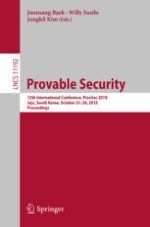2018 | OriginalPaper | Chapter
On the Hardness of Learning Parity with Noise over Rings
Authors : Shuoyao Zhao, Yu Yu, Jiang Zhang
Published in: Provable Security
Publisher: Springer International Publishing
Activate our intelligent search to find suitable subject content or patents.
Select sections of text to find matching patents with Artificial Intelligence. powered by
Select sections of text to find additional relevant content using AI-assisted search. powered by
